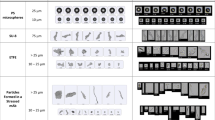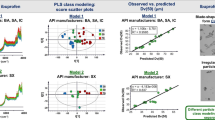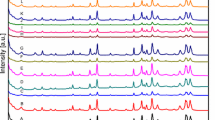Abstract
Visible particle identification is a crucial prerequisite step for process improvement and control during the manufacturing of injectable biotherapeutic drug products. Raman spectroscopy is a technology with several advantages for particle identification including high chemical sensitivity, minimal sample manipulation, and applicability to aqueous solutions. However, considerable effort and experience are required to extract and interpret Raman spectral data. In this study, we applied machine learning algorithms to analyze Raman spectral data for visible particle identification in order to minimize expert support and improve data analysis accuracy. We manually prepared ten types of particle standard solutions to simulate the particle types typically observed during manufacturing and established a Raman spectral library with accurate peak assignments for the visible particles. Five classification algorithms were trained using visible particle Raman spectral data. All models had high prediction accuracy of >98% for all types of visible particles. Our results demonstrate that the combination of Raman spectroscopy and machine learning can provide a simple and accurate data analysis approach for visible particle identification.
Graphical abstract





Similar content being viewed by others
References
CFR 21 Part 211 Current good manufacturing practice for finished pharmaceuticals. Office of the Federal Register. National Archives and Records Administration. 2020. https://www.accessdata.fda.gov/scripts/cdrh/cfdocs/cfcfr/CFRSearch.cfm?CFRPart=211. Accessed 6 Oct 2021.
EU GMP Annex 1 Revision: manufacture of sterile medicinal products (draft). European Commission. 2020. https://www.gmp-compliance.org/files/guidemgr/2020_annex1ps_sterile_medicinal_products_en.pdf. Accessed 6 Oct 2021.
General Chapter: USP. <790> Visible particulates in injections. In: USP-NF. Rockville, MD: USP; May 1, 2016. https://doi.org/10.31003/USPNF_M7197_01_01
Jiskoot W, Randolph TW, Volkin DB, Middaugh CR, Schöneich C, Winter G, et al. Protein instability and immunogenicity: roadblocks to clinical application of injectable protein delivery systems for sustained release. J Pharm Sci. 2012;101(3):946–54. https://doi.org/10.1002/jps.23018.
Jiskoot W, Kijanka G, Randolph TW, Carpenter JF, Koulov AV, Mahler HC, et al. Mouse models for assessing protein immunogenicity: lessons and challenges. J Pharm Sci. 2016;105(5):1567–75.
General Chapter: USP. <1790> Visual inspection of injections. In: USP-NF. Rockville, MD: USP; May 1, 2022. https://doi.org/10.31003/USPNF_M7198_06_01
ICH. International Conference on Harmonisation of Technical Requirements for Registration of Pharmaceuticals for Human Use. ICH Q10 Pharmaceutical Quality System (PQS). 2009. [accessed 2021 Oct 6]. https://www.fda.gov/media/71553/download
Li GG, Cao S, Jiao N, Wen ZQ. Classification of glass particles in parenteral product vials by visual, microscopic, and spectroscopic methods. PDA J Pharm Sci Technol. 2014;68(4):362–72. https://doi.org/10.5731/pdajpst.2014.00986.
Idris AM, El-Zahhar AA. Indicative properties measurements by SEM, SEM-EDX and XRD for initial homogeneity tests of new certified reference materials. Microchem J. 2019;146:429–33.
Brückl L, Hahn R, Sergi M, Scheler S. A systematic evaluation of mechanisms, material effects, and protein-dependent differences on friction-related protein particle formation in formulation and filling steps. Int J Pharm. 2016;511(2):931–45.
Nashed-Samuel Y, Torraca G, Liu D, Fujimori K, Zhang Z, Wen ZQ, et al. Identification of an extraneous black particle in a glass syringe: extractables/leachables case study. PDA J Pharm Sci Technol. 2010;64(3):242–8.
Semenova D, Silina YE. The role of nanoanalytics in the development of organic-inorganic nanohybrids-seeing nanomaterials as they are. Nanomaterials (Basel). 2019;9(12):1673. https://doi.org/10.3390/nano9121673.
Stefaniak EA, Worobiec A, Potgieter-Vermaak S, Alsecz A, Van Grieken R. Molecular and elemental characterisation of mineral particles by means of parallel micro-Raman spectrometry and scanning electron microscopy/energy dispersive X-ray analysis. Spectrochim Acta Part B At Spectrosc. 2006;61(7):824–30.
Bulska E, Wagner B. Quantitative aspects of inductively coupled plasma mass spectrometry. Philos Trans A Math Phys Eng Sci. 2016;374(2079):20150369. https://doi.org/10.1098/rsta.2015.0369.
Benevides JM, Overman SA, Thomas GJ Jr. Raman spectroscopy of proteins. Curr Protoc Protein Sci 2004;Chapter 17. https://doi.org/10.1002/0471140864.ps1708s33
Cao X, Wen ZQ, Vance A, Torraca G. Raman microscopic applications in the biopharmaceutical industry: in situ identification of foreign particulates inside glass containers with aqueous formulated solutions. Appl Spectrosc. 2009;63(7):830–4. https://doi.org/10.1366/000370209788701026.
Caudron E, Tfayli A, Monnier C, Manfait M, Prognon P, Pradeau D. Identification of hematite particles in sealed glass containers for pharmaceutical uses by Raman microspectroscopy. J Pharm Biomed Anal. 2011;54(4):866–8. https://doi.org/10.1016/j.jpba.2010.10.023.
Singh SK, Afonina N, Awwad M, Bechtold-Peters K, Blue JT, Chou D, et al. An industry perspective on the monitoring of subvisible particles as a quality attribute for protein therapeutics. J Pharm Sci. 2010;99(8):3302–21. https://doi.org/10.1002/jps.22097.
Saggu M, Liu J, Patel A. Identification of subvisible particles in biopharmaceutical formulations using Raman spectroscopy provides insight into polysorbate 20 degradation pathway. Pharm Res. 2015;32(9):2877–88. https://doi.org/10.1007/s11095-015-1670-x.
Kostamovaara J, Tenhunen J, Kögler M, Nissinen I, Nissinen J, Keränen P. Fluorescence suppression in Raman spectroscopy using a time-gated CMOS SPAD. Opt. 2013;21(25):31632–45. https://doi.org/10.1364/OE.21.031632.
Wei D, Chen S, Liu Q. Review of fluorescence suppression techniques in Raman spectroscopy. Appl Spectrosc. 2015;50(5):387–406. https://doi.org/10.1080/05704928.2014.999936.
Berghian-Grosan C, Magdas DA. Raman spectroscopy and machine-learning for edible oils evaluation. Talanta. 2020;218:121176. https://doi.org/10.1016/j.talanta.2020.121176.
Berghian-Grosan C, Magdas DA. Application of Raman spectroscopy and machine learning algorithms for fruit distillates discrimination. Sci Rep. 2020;10(1):21152. https://doi.org/10.1038/s41598-020-78159-8.
Mandrell CT, Holland TE, Wheeler JF, Esmaeili S, Amar K, Chowdhury F, et al. Machine learning approach to Raman spectrum analysis of MIA PaCa-2 pancreatic cancer tumor repopulating cells for classification and feature analysis. Life (Basel). 2020;10(9):181. https://doi.org/10.3390/life10090181.
Zhang L, Li C, Peng D, Yi X, He S, Liu F, et. al. Raman spectroscopy and machine learning for the classification of breast cancers. Spectrochim Acta A Mol Biomol Spectrosc 2022;264:120300. https://doi.org/10.1016/j.saa.2021.120300
Lu W, Chen X, Wang L, Li H, Fu YV. Combination of an artificial intelligence approach and laser tweezers Raman spectroscopy for microbial identification. Anal Chem. 2020;92(9):6288–96. https://doi.org/10.1021/acs.analchem.9b04946.
Le L, Kégl B, Gramfort A, Marini C, Nguyen D, Cherti M, et al. Optimization of classification and regression analysis of four monoclonal antibodies from Raman spectra using collaborative machine learning approach. Talanta. 2018;184:260–5. https://doi.org/10.1016/j.talanta.2018.02.109.
Zhang C, Springall JS, Wang X, Barman I. Rapid, quantitative determination of aggregation and particle formation for antibody drug conjugate therapeutics with label-free Raman spectroscopy. Anal Chim Acta. 2019;1081:138–45. https://doi.org/10.1016/j.aca.2019.07.007.
Vollrath I, Mathaes R, Sediq AS, Jere D, Jörg S, Huwyler J, et al. Subvisible particulate contamination in cell therapy products - can we distinguish? J Pharm Sci. 2020;109(1):216–9. https://doi.org/10.1016/j.xphs.2019.09.002.
Ringnér M. What is principal component analysis? Nat Biotechnol. 2008;26(3):303–4. https://doi.org/10.1038/nbt0308-303.
Pandya R, Pandya J. C5.0 algorithm to improved decision tree with feature selection and reduced error pruning. Int J Comput Appl. 2015;117:18–21.
Sun J, Zhao H. The application of sparse estimation of covariance matrix to quadratic discriminant analysis. BMC Bioinformatics. 2015;16:48. https://doi.org/10.1186/s12859-014-0443-6.
Lee Y. Support vector machines for classification: a statistical portrait. Methods Mol Biol. 2010;620:347–68. https://doi.org/10.1007/978-1-60761-580-4_11.
Abu Alfeilat HA, Hassanat A, Lasassmeh O, Tarawneh AS, Alhasanat MB, Eyal Salman HS, et al. Effects of distance measure choice on K-nearest neighbor classifier performance: a review. Big Data. 2019;7(4):221–48. https://doi.org/10.1089/big.2018.0175.
Gul A, Perperoglou A, Khan Z, Mahmoud O, Miftahuddin M, Adler W, et al. Ensemble of a subset of kNN classifiers. Adv Data Anal Classif. 2018;12(4):827–40. https://doi.org/10.1007/s11634-015-0227-5.
Wiley JH, Rajai H, Atalla RH. Band assignments in the Raman spectra of celluloses. Carbohydr Res. 1987;160:113–29. https://doi.org/10.1016/0008-6215(87)80306-3.
Movasaghi Z, Rehman S, Rehman IU. Raman spectroscopy of biological tissues. Appl Spectrosc. 2007;42(5):493–541. https://doi.org/10.1080/05704920701551530.
Liu H, Yu W. Study of the structure transformation of wool fibers with Raman spectroscopy. J Appl Polym Sci. 2007;103:1–7.
Andreassen E. Infrared and Raman spectroscopy of polypropylene. In: Karger-Kocsis J, editor. Polypropylene, Polym Sci Technol Ser, vol. 2; 1999. p. 320–8. https://doi.org/10.1007/978-94-011-4421-6_46.
Jayes L, Hard AP, Séné C, Parker SF, Jayasooriya UA. Vibrational spectroscopic analysis of silicones: a Fourier transform-Raman and inelastic neutron scattering investigation. Anal Chem. 2003;75(4):742–6. https://doi.org/10.1021/ac026012f.
Nallasamy P, Mohan S. Vibrational spectroscopic characterization of form II poly (vinylidene fluoride). Indian J Pure Appl Phys. 2005;43:821–7.
Lobo H, Bonilla JV (Eds.). Handbook of plastics analysis (1st ed.). CRC Press. 2003;265-266. https://doi.org/10.1201/9780203911983
Abdelrazek EM, Abdelghany AM, Oraby AH, Morsi MA. Effect of inorganic filler in the structural and optical properties of polyether sulfone. Res J Pharm Biol Chem Sci. 2012;3(4):277–93.
Mihály J, Sterkel S, Ortner H, Kocsis L, Hajba L, Furdyga E, et al. FTIR and FT-Raman spectroscopic study on polymer based high pressure digestion vessels. Croat Chem Acta. 2006;79(3):79.
Han C, Chen M, Rasch R, Yu Y, Zhao B. Structure studies of silicate glasses by raman spectroscopy. In: Reddy RG, Chaubal P, Pistorius PC, Pal U. (eds) Advances in molten slags, fluxes, and salts: Proceedings of the 10th International Conference on Molten Slags, Fluxes and Salts. 2016;p. 175-182 . https://doi.org/10.1007/978-3-319-48769-4_18
Gómez de la Cuesta R, Goodacre R, Ashton L. Monitoring antibody aggregation in early drug development using Raman spectroscopy and perturbation-correlation moving windows. Anal Chem. 2014;86(22):11133–40. https://doi.org/10.1021/ac5038329.
Funding
This work was supported by the Medical Engineering Fund of Fudan University (yg2021-022), Pioneering Project of Academy for Engineering and Technology of Fudan University (gyy2018-001, gyy2018-002), Shanghai Key Discipline Construction Plan (2020-2022) (Grant No. GWV-10.1-XK01), and National Natural Science Foundation of China (62175034, 62175036).
Author information
Authors and Affiliations
Contributions
• Substantial contributions to the conception or design of the work or the acquisition, analysis, or interpretation of data for the work: Jiong Ma, Lan Mi, Han Sheng, Yinping Zhao, and Xiangan Long
• Drafting the work or revising it critically for important intellectual content: Han Sheng, Yinping Zhao, Xiangan Long, Liwen Chen, Bei Li, and Yiyan Fei
• Final approval of the version to be published: Jiong Ma, and Lan Mi
• Agreement to be accountable for all aspects of the work in ensuring that questions related to the accuracy or integrity of any part of the work are appropriately investigated and resolved: Han Sheng, Yinping Zhao, Xiangan Long, Liwen Chen, Bei Li, Yiyan Fei, Lan Mi, and Jiong Ma
Corresponding authors
Ethics declarations
Conflict of Interest
The authors declare no competing interests.
Additional information
Publisher’s Note
Springer Nature remains neutral with regard to jurisdictional claims in published maps and institutional affiliations.
Rights and permissions
About this article
Cite this article
Sheng, H., Zhao, Y., Long, X. et al. Visible Particle Identification Using Raman Spectroscopy and Machine Learning. AAPS PharmSciTech 23, 186 (2022). https://doi.org/10.1208/s12249-022-02335-4
Received:
Accepted:
Published:
DOI: https://doi.org/10.1208/s12249-022-02335-4




